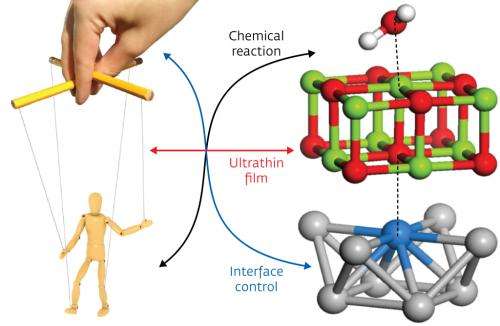Impurity atoms impart remarkable control over water-splitting reactions on insulator surfaces

Ultra-thin inorganic oxide films are set to play vital roles in future catalytic systems, according to findings from Jaehoon Jung and Yousoo Kim at RIKEN's Advanced Science Institute in Wako and two colleagues in Japan and Korea. Through high-level computer simulations, the team discovered that small amounts of impurity atoms, or dopants, in ultra-thin oxides can systematically lower chemical reaction barriers—giving chemists a new tool for optimizing catalytic processes such as hydrogen-fuel generation.
Materials scientists are intrigued by ultra-thin oxides because they allow 'fine-tuning' of surface chemical reactions. For example, Jung, Kim and colleagues recently used silver crystals coated with magnesium oxide (MgO) to break individual water molecules into proton and hydroxyl ions through multiple vibrational excitations. The insulating MgO layer decouples interactions between absorbed water molecules and the underlying silver substrate just enough to activate specific water-splitting pathways. Varying the oxide thickness provides an additional dimension of control over this catalysis.
Most recently, the team focused on a relatively unexplored technique to tailor the reactivity of MgO/silver surfaces even further: inserting transition metal dopant atoms into the interfacial surface structure. Jung explains that the 'd-type' electrons of transition metals such as titanium, iron, and copper provide predictable charge effects that can influence the catalytic and magnetic properties of oxide materials.
To explore this concept, the researchers used quantum chemistry computations to model two-atomic-layer-thick MgO on top of a periodic silver crystal. When they replaced a silver atom with a dopant, they saw that oxygen atoms attracted transition metals to the MgO/silver interface through a 'drawing effect'. By systematically switching between transition metals containing ever-increasing d-electrons, the researchers found they could use this effect to precisely control interfacial dopant concentrations—a boon for practical applications of this technology.
The team's calculations revealed that hybridization between transition metal d-electrons and the ultra-thin oxide creates an effect that increases adhesion between the MgO and silver layers. In turn, surfaces with higher MgO/silver adhesion have sharply enhanced water-splitting capabilities. A linear correlation between dopant d-electron count and chemical reactivity leaves the researches hopeful this approach can lead to accurate interface engineering of other catalytic processes.
"To control surface reactions, we need to look beyond just surface modification, which usually has unwanted side effects," says Jung. "We revealed that chemical reactivity on MgO/silver surfaces is correlated with adhesion properties well-described by textbook theory. These are guidelines—sticks and wires that can be used to manipulate the 'marionette' of chemical activity."
More information: Jung, J., Shin, H.-J., Kim, Y. & Kawai, M. Ligand field effect at oxide-metal interface on the chemical reactivity of ultrathin oxide film surface.Journal of the American Chemical Society 134, 10554–10561 (2012). pubs.acs.org/doi/abs/10.1021/ja302949j
Shin, H.-J., Jung, J., Motobayashi, K., Yanagisawa, S., Morikawa, Y., Kim, Y. & Kawai, M. State-selective dissociation of a single water molecule on an ultrathin MgO film. Nature Materials 9, 442–447 (2010). www.nature.com/nmat/journal/v9 … n5/abs/nmat2740.html
Jung, J., Shin, H.-J., Kim, Y. & Kawai, M. Controlling water dissociation on an ultrathin MgO film by tuning film thickness. Physical Review B 82, 085413 (2010). prb.aps.org/abstract/PRB/v82/i8/e085413
Journal information: Journal of the American Chemical Society , Nature Materials , Physical Review B
Provided by RIKEN
















